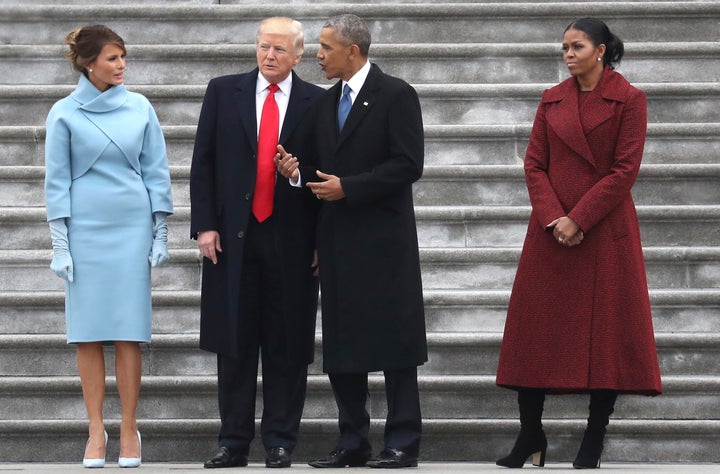
For well over a year now, experts have been predicting disaster from President Donald Trump’s trade war with China. It would wreck Christmas shopping, ruin the board game industry and drive up the price of fancy sweaters. According to the august analysts at the New York Federal Reserve, Trump’s tariffs cost an average of $414 per household last year and will cost another $831 over the coming year. The top Senate Democrat on trade, Ron Wyden of Oregon, recently warned that the tariffs could increase consumer prices by up to 25 percent by the time back to school shopping is through.
This, we are told, is just Econ 101. Tariffs raise prices on consumers and by doing so, limit economic growth. Trump’s tariffs, therefore, are a celebration of ignorance, a grotesquerie cribbed from medieval alchemists. Last year, The Washington Post’s Catherine Rampell even argued that Trump’s trade program was quite literally a relic of the 1680s.
Recent history has a way of painting the distant past in its own colors. It’s true that since the 1990s, both Democratic and Republican administrations have generally pursued tariff reductions, imposing import tariffs only as a last resort. And yet tariffs have always been a pretty routine element of U.S. economic policy. The second piece of legislation President George Washington signed into law was a 5 percent tariff applied to most imports. The latest official Harmonized Tariff Schedule published by the U.S. International Trade Commission includes 22 sections and 99 chapters ― plus appendices for chemicals, dyes and pharmaceutical products ― coming to 3,888 pages of information. Very little of it is Trump’s handiwork.
Apocalypse Trade may yet come, but so far, its would-be Cassandras have been Chickens Little. Consumer spending rose last holiday season. Total U.S. manufacturing employment is up very modestly since Trump began his tariff campaign, while overall unemployment has continued its downward drift to levels unseen since the 1960s.
If you didn’t notice losing $400 last year, you aren’t alone. The New York Fed’s analysis is a mess of theory and assumption that conflicts with basic inflation data. Consumer prices have essentially been flat since the tariffs were imposed.
None of this means Trump’s trade war is a success. In fact, it’s much worse than the Econ 101 scolds let on. Behind all of his bluster and bravado, Trump is essentially pursuing the same international economic agenda as his recent predecessors ― an agenda that can only be described as an abject, bipartisan failure. And the stakes in this drama are much higher than a few dollars a month at Target or Amazon.
“Behind all of his bluster and bravado, Trump is essentially pursuing the same international economic agenda as his recent predecessors.”
Trade between the United States and China is, like all international commerce, a political arrangement. There is no “natural” or “free” way for two nations with different laws and political systems to conduct their affairs together, and the relationship between the United States and China was strained long before Trump’s inauguration.
It is not a secret that American corporations have outsourced much of their manufacturing activity to China over the past two decades. Economists dispute exactly how much of the domestic job loss is attributable to trade, but leading scholars believe the U.S. lost roughly 1 million manufacturing jobs to China during the first decade of the 21st century, and there is reason to suspect the outflow continues today in some sectors.
China does not have some innate aptitude for manufacturing. The climate in Shenzen is not better suited for cranking out electronics than that of San Francisco or Des Moines. The reason so much of the world’s manufacturing moved to China in the early years of this century is that the Chinese and American governments implemented policies designed to make it happen.
The signature elements of this program are low wages for workers in China, loose regulations for companies operating in China, and systematic under-valuation of China’s currency, the yuan. Low wages and hands-off regulatory policies cut corporate costs, enabling made-in-China products to secure higher profits. These efforts are strongly reinforced by the Chinese government’s policy of maintaining a “weak” yuan. By keeping the international value of China’s currency low, Chinese goods can sell for less in American markets, undercutting made-in-America producers.
Workers in China earn an average wage of about $3.40 an hour, according to the research firm Euromonitor, which compares to an average wage in the U.S. of about $27.83. This differential is enabled by lower costs of living in China, but also through simple worker repression. It’s illegal, for instance, to form a labor union in China independent of the ruling Communist Party. On the currency front, China hasn’t directly intervened in currency markets to devalue for several years now, but by holding on to about $4 trillion in dollar-denominated assets as reserves, China elevates the value of the dollar against the yuan.
So the U.S. simultaneously exported manufacturing jobs and much of its dirtier, carbon-intensive production to China in exchange for cheaper consumer goods and higher corporate profits. This is, in a nutshell, the central idea behind what was once optimistically labeled “free trade” or “globalization,” but which increasingly goes by the more ominous term “neoliberalism.”
Bill Clinton implemented this framework over the course of his presidency, relying on the ideas of George H.W. Bush and a few thinkers celebrated by the American conservative movement. He added moral heft to the arrangement by dressing it up in the language of human rights and international goodwill.
“Bringing China into the [World Trade Organization] doesn’t guarantee that it will choose political reform,” Clinton said in 2000. “But accelerating the process of economic change will force China to confront that choice sooner, and it will make the imperative for the right choice stronger.” Free trade with China, he argued, “is likely to have a profound impact on human rights and political liberty.”
By 2009, most world leaders recognized things were not going according to Clinton’s script. The “political reform” Clinton had hoped for had not materialized in China, while the United States had invaded Iraq on false pretenses and implemented a ghastly torture program. Whatever the virtues of cheap labor in China, it did not seem to have much to do with global harmony.
An economically stronger China, meanwhile, began asserting itself more forcefully on the international stage ― sometimes confronting American allies in ways that demanded U.S. attention. Things got particularly heated in 2010 and 2011 when China claimed rights to shipping, mining and drilling rights in the South China Sea ― a dispute that involved Japan, India and several other nations.
“The reason so much of the world’s manufacturing moved to China in the early years of this century is that the Chinese and U.S. governments implemented policies to accomplish exactly this outcome.”
This wasn’t just a problem for American allies. The United States itself was becoming increasingly dependent on China for an array of products that were no longer produced domestically ― from consumer electronics to specialty high-tech metal alloys. This, in turn, had given China new economic leverage over U.S. diplomatic decisions.
So in the fall of 2011, President Barack Obama announced plans to station 2,500 marines in Australia, saying his administration had made “a deliberate and strategic decision,” that “as a Pacific nation, the United States will play a larger and long-term role in shaping this region and its future.”
The troops were mostly for show. The real action involved in what became known as “the pivot to Asia” was a massive trade deal with essentially every Pacific nation the Obama administration could convince to sign on ― other than China. By strengthening U.S. economic ties with everyone else in the region, the Obama administration hoped to obtain greater leverage over China to deter geopolitical choices the United States frowned upon.
This was the Trans-Pacific Partnership, the core function of which ― despite much window-dressing to the contrary ― was not to reduce carbon emissions or advance human rights, but to diversify the abusive regimes on which the United States relied for cheap consumer goods (particularly the governments of Vietnam and Malaysia). The Obama administration eventually became so desperate to pass the deal that it upgraded Malaysia’s official human rights rating shortly after the discovery of mass human trafficking graves on the Malaysian side of the border with Thailand. As many environmental advocacy groups noted during TPP negotiations, the trade pact was inconsistent with the goals Obama pursued under the Paris climate accord.
TPP, famously, did not pass. Which brings us to Trump. Look under the hood of his economic demands against China, and they are very similar to those the Obama administration once made ― mostly calls to respect the intellectual property claims of U.S. corporations that move their operations to China and end China-backed hacking of U.S. companies. Trump is applying tariffs against hundreds of billions of dollars worth of made-in-China products in an effort to coerce China into making it easier and more profitable for American firms to move their operations to China.
In a sense, Trump is getting results. China hasn’t budged on IP, but many firms that sell to American consumers have in fact rearranged their supply chains to avoid Trump’s tariffs. The results roughly align with the aims once pursued by the Obama administration. As the U.S. trade deficit with China has declined in recent months, the trade deficit with Vietnam has increased, as noted by Brad Setser at the Council on Foreign Relations. This is one reason prices for American households haven’t really increased. Trump’s tariffs aren’t bringing manufacturing back to America; they’re shifting it from China to other low-wage countries.
And like Obama, Trump has done nothing substantive to address the national security implications of China’s effective monopoly over various critical resources. The U.S., for instance, remains entirely dependent on China for rare earth minerals ― a key ingredient in everything from light bulbs to smartphones to military weapons.
Trump, in short, is using the unilateral blunt force of a tariff program to implement many of the international goals that Obama tried and failed to secure through coordinated, multilateral negotiation. The different tactics of the two administrations have obscured their essentially common agenda.
The repugnance of this agenda in the face of domestic inequality, international political repression and accelerating global climate change renders the tariff question almost a distraction. Movements in retail prices are simply not very important when considered against the linked crises facing great power diplomacy in the 21st century.
Such complications, alas, are beyond the scope of Econ 101.
